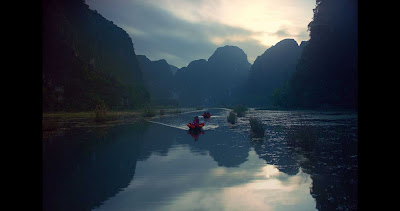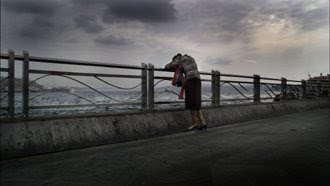“Why are you attacking your parents in court?”—Lebanese judge/magistrate to Zain, a 12-year-old Lebanese, already behind bars for a crime he has committed
“For giving me life”—Zain’s response
The year 2018 has seen the release of three interesting
films from three distinct parts of the globe. Each of the three are very interesting, have several common
themes and have and will be competing against each other for major honours at different
awards nights and film festivals. The three films are directors Nadine Labaki’s
Capernaum (from Lebanon), Hirokazu Kore’eda’s Shoplifters (from Japan) and Alfonso Cuaron’s Roma (from Mexico).
 |
| Zain (Zain al Rafaeea) pondering on ways to feed and take care of someone younger and more helpless |
All three films deal with multiple children and their families
into which they are born-- for no fault of theirs. All three films are original tales conceived
and developed by the directors from their own experiences and imaginations. All
three films deal with poverty, though in Roma
the effect of poverty is limited to the servants and not the children of
their masters who are luckily born into a world of financial security. All the
three films have already won major awards either at Cannes or at Venice film
festivals and are/were competing for the Golden Globes and the Oscars. Though Capernaum
is the weakest of the three in production quality, it offers much more to the
viewer to reflect on and appreciate than the other two films.
Perhaps, to relegate all the production aspects of in Capernaum as less stunning than Shoplifters and Roma would be quite inaccurate.
An early aerial drone shot in Capernaum
of the shantytown districts of Beirut, thanks to its cinematographer
Christopher Aoun, stuns you. What you see is a mosaic of tin sheets that act as
roofs of human habitation held in place by old rubber tires of all sorts of vehicles.
 |
| A 12-year-old Zain takes care of a 1-year-old with responsibility and love he never got from his own parents |
 |
| Zain carrying Yonas around Beirut to find food and shelter |
Assuming this low-cost camera shot in Capernaum is real and not a computer
generated perspective, that simple astounding shot deserves more credit than
the comparatively awesome beach rescue scene and the hospital delivery scene in
Roma captured by the able Mexican cinematographer/director
Cuaron with the relative high costs involved, the mainstay of the Mexican film Roma’s technical finesse. Now why would
that one shot in Capernaum be so
important? Beyond the humour and surreal perspective of Beirut that shot offers,
it encapsulates the chaos implied in the title of the film. And to place that
stunning shot at the start of the film is a master stroke of co-writer and
director Labaki.
Capernaum is a
film close to the neorealist film traditions of Vittorio de Sica (Italy) and
the contemporary works of Ken Loach (UK) and the Dardenne brothers (Belgium)
using non-professional actors to etch realistic tales of poverty in an engaging,
intelligent manner. On the other hand, Kore’eda’s Shoplifters is a film
that has used experienced actors who have appeared in films before, often in
earlier works of the director. If the
viewer of Capernaum dissects each
scene with the 12-year-old Zain (Zain al Rafaeea, a Syrian refugee in Lebanon who has never acted before playing the role of
a Lebanese kid) and the one-year-old Ethiopian child Yonas (Boluwatife Treasure
Bankole) who is not old enough to walk but can crawl, one can glimpse the mammoth
effort taken by director Labaki to capture the right emotions of the two kids
and the amount of time spent and footage
the filmmakers shot to get the final edited version of Capernaum. And it looks so real!
Capernaum offers
an unusual tale—a 12-year-old boy so frustrated with his miserable life on earth
which led him to commit a crime out of rage that results in imprisonment with
other kids of his age. From the jail, he is ingenuous enough to contact a live TV
show host on a cell phone to start the process of suing his biological parents
with an unusual demand that his mother abort the foetus that she is carrying. He
does not want yet another child to be born into his family of illiterate and
incompetent parents, who neither have money or time for their offspring but
continue to breed.
 |
| Zain in court speaks to the judge with his lawyer (director and co-scriptwriter Nadine Labaki) standing next to him |
While Capernaum is a plea to parents worldwide who cannot afford to have another mouth to feed and to
stop procreating further, it is equally an unsettling plea against child
marriages, where a girl child (Zain’s younger sister Sahar) can be given off in
marriage in exchange of five chickens to feed the family for a few days. It is a plea by a child who has never been to
school on behalf of the children of the world for a right to education and their
right to the joys of childhood. In stark
contrast to the children in Shoplifters,
who experience love of parents, grandparents and foster-parents, the
children in Capernaum are pushed by
poverty to survive from day to day employing ingenious methods of drug peddling
and their incredible transmission of opioid medication routes to survive and generate
income to help other kids, more fragile than themselves, live another day.
 |
| The illegal Ethiopian migrant Rahil in Lebanon in search of a better life for herself and her son Yonas |
Capernaum prods
the viewer to spread the word on the importance of sterilizing illiterate
parents already burdened with kids, blind to the travails of their progeny
present and future. It is a film that underscores the importance of registering
the births of children in today’s global village to have their own identity and
rights in their own country that will help them in their life. It is also about
paperless emigrants: an Ethiopian single mother Rahil (Yordanos Shiferaw) ekes
out a living in Lebanon, evidently because Lebanon offers her a better life
than in Ethiopia and in a similar flip-side scenario to escape poverty the Lebanese Zain goes
scrounging for his identity papers (that never existed because his parents
never bothered) so that he and Yonas could be transported to Turkey and/or
Europe as immigrants also seeking a better life. The film’s unspoken message is
that immigration problem starts at home, with parents who are responsible for
the upbringing of the family rather than curse their own financial predicament.
It is thus not unusual to find brothers being more responsible for the fate of
their sisters than the parents in the Middle East. The many Zains of Lebanon do
manual child labor to survive each day while more privileged children head to school
in small vans covered with their schoolbags.
In Biblical terms, Capernaum in Galilee was where Jesus
began his ministry, performing miracles, and a town cursed by Jesus unless the people repented.
In Labaki’s Capernaum, there is
scope for the parents to repent after hearing Zain’s plea from behind bars and
sterilize themselves or adopt other temporary birth control methods so that other Zains are not brought forth into the world. Labaki’s Capernaum
might be focusing on a small portion of Beirut—but the message of her film is
universal. One is again reminded of the iconic
shot from the sky of Beirut’s shacks with tin sheet ceilings held in place with
old tires.
 |
| Zain and his younger sister Sahar who will be given away in marriage by his parents for the price of five chickens |
Though Labaki’s Capernaum
lacks the financial and acting prowess of Roma
and Shoplifters, the strength of the
film is in the message and the ability of the filmmaker to work with a 9-year-old
Syrian Zain playing a 12-year-old Lebanese with the same name. The fictional character Zain cares for those
weaker than himself and, in jail, shows a maturity beyond his physical age to
envisage a similar fate as his that awaits his future brothers and sisters
unless he acted quickly against his parents. Director Labaki plays the role of
Zain’s lawyer in the film. Step back and the viewer will realize that Labaki is
the “lawyer” making an impassioned plea for a better deal for children of poor
illiterate parents who disregard sterilization and beget children deprived of food,
education and love and plead innocence without taking responsibility as production
of children is equated with currency.
The
more economically stable film viewers of Capernaum
can scoff at the concept of a child suing his parents, but it is a viewpoint
few filmmakers would have dared to address till now.
Capernaum is the film of 2018 and arguably the
best film from the Middle East in a long, long while.
P.S. The lovable Zain al
Rafaeea, who is the main actor, is now a legal immigrant in a Scandinavian
country with his parents. Capernaum
is the winner of the Jury Prize and
two other awards at the Cannes film festival; award for direction at the Asia
Pacific Screen Awards; best screenplay award at the Stockholm Film Festival,
audience awards at Calgary, Acadie, Ghent, Melbourne, Mill Valley, Norway,
Sarajevo, St Louis, Sao Paulo, and Toronto international film festivals. The author's ranked list of the top 20 films of 2018 includes Capernaum.






































